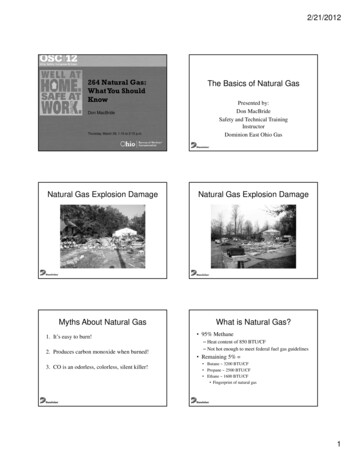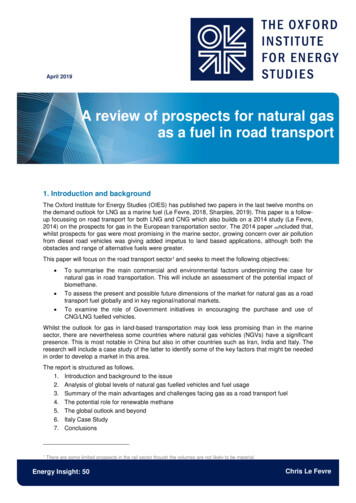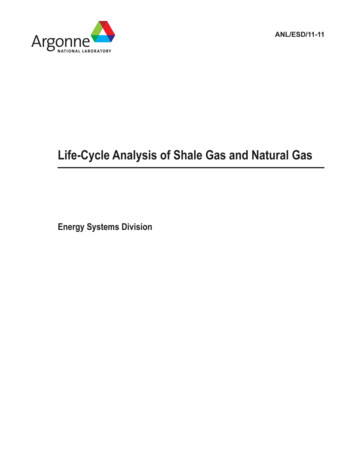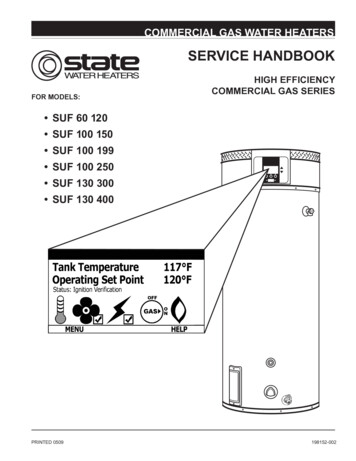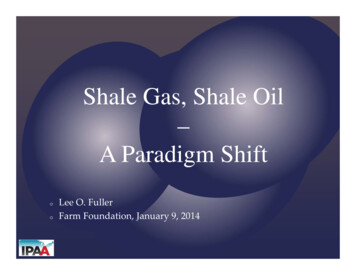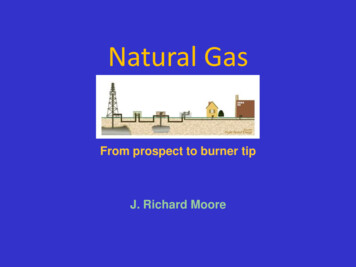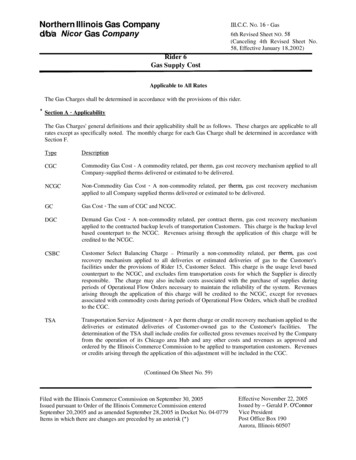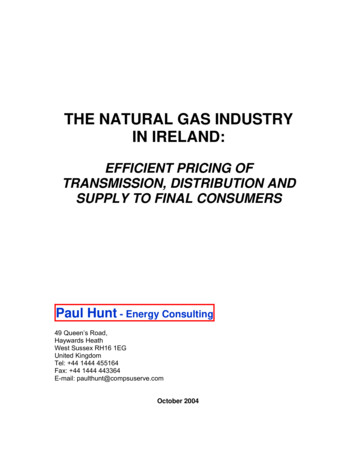
Transcription
THE NATURAL GAS INDUSTRYIN IRELAND:EFFICIENT PRICING OFTRANSMISSION, DISTRIBUTION ANDSUPPLY TO FINAL CONSUMERSPaul Hunt - Energy Consulting49 Queen’s Road,Haywards HeathWest Sussex RH16 1EGUnited KingdomTel: 44 1444 455164Fax: 44 1444 443364E-mail: paulthunt@compsuserve.comOctober 2004
Paul Hunt - Energy ConsultingTable of Contents1EXECUTIVE SUMMARY . 41.11.21.31.4Gas prices are increasing rapidlyUnit costs of gas delivery are unjustifiably highUnit costs of gas delivery can, and should, be reducedFinal gas prices do not have to increase in real terms2BACKGROUND AND INTRODUCTION . 52.12.22.3Increases in Final Gas PricesThe Commission’s ExplanationAre the Price Increases Justified?2.3.12.3.22.3.3Higher Wholesale Gas PricesCompetitiveness of GasRestricting the National Reliance on Gas44445566662.4The Need for Further Investigation3THE UNIT COSTS OF TRANSMISSION ANDDISTRIBUTION IN IRELAND AND BRITAIN. 83.13.2Basis of Unit Cost ComparisonEvaluation of Comparison3.2.13.2.2InterconnectorsDirectly Comparable Components7899104TRANSMISSION AND DISTRIBUTION COST BASES. 124.1Establishing the Regulatory Asset Base4.1.14.1.24.1.34.24.3Developing Pro Forma AccountsNet Asset Valuation and Financing4.3.14.3.24.4The Flaw in the Commission’s MethodApplication of Regulatory Accounting PrinciplesThe Impact of the Required AdjustmentThe Market Asset RatioRecoverable and Unrecoverable InvestmentsDeriving a Value for the MAR4.4.14.4.24.4.3Applying a Consistent Debt PercentageAn Estimate of the MARImpact on T&D Unit Costs and Final Prices1212141616171718202021215JUSTIFYING THE CHANGE . 265.15.25.35.45.5BenefitsLearning from the British ExperienceAbility to Estimate Market ValuationRegulatory and Commercial ConsistencyEase of Implementation22626262626
Paul Hunt - Energy ConsultingTable of Contents6SOME FURTHER CONSIDERATIONS. 276.1Possible Objections from Bord Gáis6.1.16.1.2Cost and Availability of Debt FinancingStranded Assets and Regulatory Opportunism2727276.2The Department of Finance277CONCLUSIONS AND WAY FORWARD. 287.17.2ConclusionsA Possible Way Forward28283
Paul Hunt - Energy ConsultingExecutive Summary1EXECUTIVE SUMMARY1.1Gas prices are increasing rapidlyThe Commission for Energy Regulation has decided to increase gas prices forhousehold and non-household consumers of gas using less than 5.3 GWh a year by10.9% and 16%, respectively, from 1 October 2004. Wholesale gas prices in Britainand throughout Europe have increased considerably in the last year and areexpected to remain high. Higher wholesale prices in Britain have a direct impact onfinal prices in Ireland, but these increases follow an increase of 9% introduced on 1April 2003. Final prices may have been kept artificially low during the 1990s, butprice increases of this scale will retard the expansion of gas utilisation and of thecapture of the important benefits it confers.1.2Unit costs of gas delivery are unjustifiably highUnit costs of transmission and distribution in Ireland are between two and threetimes the corresponding unit costs in Britain. For comparison purposes fourseparate transportation business units are identified - Interconnectors, Transmission 40barg, Distribution and Meters. With the exception of Interconnectors thesecorrespond to the transportation business units in Britain. The usual reasonsadvanced (low population density, dispersion of urban settlements, inability tocapture economies of scale, the relative newness of the Irish networks, etc.) areinsufficient to explain these differences. This leads to an examination of thetransmission and distribution cost bases.1.3Unit costs of gas delivery can, and should, be reducedThe Commission allows Bord Gáis Transmission and Distribution (BGT&D) fullrecovery of, and a rate of return on, its net asset values at indexed historic cost(IHC). Bord Gáis prepares its financial accounts under the historic cost convention.IHC considerably over-states the actual asset values. In addition the allowedregulatory rate of return is based on a debt percentage of 55%. BGT&D’s effectivedebt percentage (on an IHC basis) is approximately 37%. A write-down of theState’s ownership interest in Bord Gáis (represented by the Profit Reserve) to a levelthat corresponds to a debt percentage (on an IHC basis) of 55% reflects anappropriate measure both of the market valuation of the businesses and of therecovery of sunk costs. This results in unit cost reductions ranging from 18 to 25%.1.4Final gas prices do not have to increase in real termsThe resulting reduction in transmission and distribution tariffs should, more or less,keep final prices unchanged in real terms. In addition, the reduction in transmissiontariffs will reduce the cost of gas-fired electricity generation and should reduce theincreases in final electricity prices. And the financial re-structuring proposed mayhave relevance for electricity transmission and distribution.It is clear that the Commission will resist any changes to the prices and tariffs it hasdetermined; the Minister is not empowered to set prices and tariffs. It may benecessary to establish a Government Inquiry to determine an efficient and equitablebalance between the interests of final consumers and the interests of the State.4
Paul Hunt - Energy ConsultingBackground and Introduction2BACKGROUND AND INTRODUCTION2.1Increases in Final Gas PricesOn 30 September 2004 the Commission for Energy Regulation (the Commission)issued its decisions on the allowed revenue of Bord Gáis Energy Supply (BGES)from supply, and on the level of supply tariffs, to final customers consuming less than5.3GWh a year. These decisions confirmed proposed decisions published on 3September 2004.1 Household customers face a gas price increase of 10.9% andnon-household customers of 16% for the Gas Year beginning 1 October 2004.These increases follow a 9.1% increase introduced on 1 April 2003.At first sight it is somewhat surprising that, since the Commission was empoweredby the Gas (Interim) (Regulation) Act 2002 to regulate charges for gas transmissionand distribution and the prices for supply to final consumers, gas prices have risenso rapidly. However, it is necessary to recognise that, during the decade prior to theextension of the Commission’s powers and duties, Bord Gáis Éireann (Bord Gáis)minimised increases in final prices and, for a number of years, maintained a ‘pricefreeze’. As Ireland became more dependent on imports (at prices higher than thosefor indigenous inputs) the levels of costs and prices began to diverge. A prima faciecase began to emerge that, on both financial and economic grounds, some remedialaction was required.2.2The Commission’s ExplanationThe Commission provides the following explanation for the current increases in finalprices:“BGS’s natural gas supply tariffs to all gas customers consuming below 5.3 GWh perannum have remained unchanged since 1 April 2003 while the underlying costs to supplyhave increased, particularly gas procurement costs. The gas procurement component ofthe supply tariff accounts for approximately 40% of total cost of service. Gas prices onthe International Petroleum Exchange (IPE) have increased significantly, particularly inthe past 2 years.In addition to gas procurement costs, the supply tariffs recover transportation costs(distribution and transmission) as well as BGS’s operating costs. Each of these costs hasalso risen, albeit to a lesser extent than the procurement costs, since 1 April 2003.As a result current tariffs do not reflect the underlying costs of service. This iseconomically inefficient. It does not allow BGS to recover the costs it incurs in purchasingnatural gas or the costs of transmitting, distributing and supplying gas to customers. Atthe same time, tariffs that do not reflect the cost of service distort consumption andinvestment decisions.For these reasons, the Commission considers it necessary that tariffs be raised to moregenerally cost-reflective levels, enabling BGS to recover its costs and new entrantsuppliers to compete with BGS to supply final (eligible) customers.1“Proposed Decision on Bord Gáis Energy Supply’s Revenue for the period 1 October 2004 to30 September 2005”, 3 September, CER/04/286 and “Proposed Decision on Bord GáisEnergy Supply’s Natural Gas Supply Tariffs to Final Customers: 1 October 2004 to 30September 2005”, 3 September 2004, CER/04/287.5
Paul Hunt - Energy ConsultingBackground and IntroductionThis supply price review is being conducted in the context of the liberalisation of the gassupply market in Ireland. All non-domestic customers have been eligible since 1 July2004 to choose a gas supplier other than BGS. It is anticipated that full market opening,which will give all customers, including domestic customers, the option of choosing asupplier of gas other than BGS, will occur in 2005.” (CER/04/287, p3)These price increases are justified if all the components that make up these finalprices are being priced (or costed) in an economically efficient manner. Since all thecomponents are subject to either regulatory scrutiny or control, there appears to belimited grounds for questioning the justification for these price increases.2.3Are the Price Increases Justified?A number of factors may contribute to a sense of resignation in the face of theseprice increases. Three factors are considered in turn.2.3.1 Higher Wholesale Gas PricesEuropean wholesale prices are high, and are likely to remain high, for a number ofreasons. These include oil price indexation in long term supply contracts and theability of large-volume external suppliers to exercise supply-side market power in theface of increasing fragmentation of the existing demand-side market power.Resolving these, and similar issues, is beyond the control of the Irish gas industry;they may be addressed successfully only at a pan-European level.Some increase in final prices is to be expected, but the cost of gas is only onecomponent among those that comprise final prices.2.3.2 Competitiveness of GasThe second factor is the expectation that, even if final gas prices are high, gas willremain competitive with substitutable fuels. This expectation is plausible becausethere is limited de-coupling of oil and gas prices, consumers experience inertia andare reluctant to incur the costs of switching away from gas and gas producers, eventhough they will seek to price up to willingness-to-pay (WTP) levels, will not attemptto price gas out of the market.Although this expectation may be plausible, it is only plausible in the context of amarket where gas penetration is reaching saturation. This is certainly not the case inIreland. In addition, in the context of Ireland’s economic performance, there is lessconcern about affordability.2.3.3 Restricting the National Reliance on GasThe third factor focuses on concerns about security of supply and excessive relianceon gas in primary energy consumption (PEC). The idea that the penetration of gasin the economy should be, somehow, restrained has gained some traction in policyand popular sentiment.However, the current share of gas in PEC is largely determined by the extent of gasfired electricity generation. Gas’s share in other sectors is considerably less than itsefficient potential. The determination of an appropriate generation fuel-mix thattakes account of security of supply concerns is a matter for the electricity supplyindustry in conjunction with the policy-makers.6
Paul Hunt - Energy Consulting2.4Background and IntroductionThe Need for Further InvestigationThese three factors may contribute to the current level of final prices, but their impactis insufficient to justify the current levels. Following the decision on the latestincreases prices to household and non-household consumers will have increased bya compound 21% and 27% respectively in the space of 18 months. The size ofthese successive price increases in real terms may provide some ‘headroom’ forcompeting suppliers, but they also run the risk of hindering the penetration of gas.Increased penetration of natural gas confers significant economic, environmentaland strategic benefits. It is vital to maximise the efficiency of the delivery andexpansion of supply to ensure that these benefits are captured. The focus has to beon the procedures and costs that are in the control of the national industry.As a result these price increases merit further investigation. This paper focuses onthe components of final prices that are subject to day-to-day control by BGT&D andto ultimate control by the Commission. It examines the effectiveness and efficiencyof the current regulatory control, identifies specific deficiencies and outlines thepolicy and regulatory changes required to remedy these deficiencies.The discussion and analysis presented in this paper are based solely on informationavailable in the public domain and is referenced accordingly.7
Paul Hunt - Energy Consulting3Unit Cost of Transmission and DistributionTHE UNIT COSTS OF TRANSMISSION ANDDISTRIBUTION IN IRELAND AND BRITAINAmong the cost components included in final prices, the costs of transmission anddistribution are the most readily subject to control by BGT&D and the Commissionand provide an appropriate point of departure. On 23 July 2003 and 7 August 2003,the Commission issued its decision documents on price controls, respectively, fortransmission and distribution.2 On 3 September 2004 the Commission issued itsdecisions on the transmission and distribution price controls for 2004/05.3 Thesedecisions modify the allowed revenues and tariffs in the light of the out-turn for2003/04. Since the material modifications relate to out-turn under- or over-recoveryof revenue, the projections employed in the previous year’s decision documents areretained for the purposes of this analysis.These documents provide the basis for Table 3.1 which compares and contrasts thecosts of gas delivery in Ireland and Britain. British data are extracted from Ofgem’sfinal proposals on Transco’s price control from 2002.43.1Basis of Unit Cost ComparisonThe data are expressed in Euro cents (2004 prices) for the gas years beginning on 1October. Unit costs in Britain have been converted to Euro cents using the currentexchange rate of 1.4735/ .The Commission’s decision documents identify separate revenue requirements forInch (the entry point for gas from the Kinsale Head Field (and adjacent fields), for theinterconnectors and for onshore transmission and for distribution. For the purposesof comparison with British data, the Inch revenue requirement is included in theTransmission total. It is estimated that 20% of the onshore transmission revenuerelates to pipelines designed to operate at pressures less than 40 barg. Thisrevenue has been excluded from the Transmission total and included in Distribution.In addition it is assumed that one sixth of total Distribution revenue relates toMeterwork and Metering and this is excluded from Distribution and presented as aseparate business.The revised allocation of the individual revenue requirements (and allowed costs)allows unit costs to be derived and compared directly with those derived for the gasdelivery businesses in Britain.234“Commission’s Decision on Transmission Use of System Revenue Requirement and TariffStructure: 1 October 2003 to 30 September 2007”, 23 July 2003, CER/03/172 and“Commission’s Decision on Distribution Use of System Revenue Requirement and TariffStructure: 1 October 2003 to 30 September 2007”, 7 August 2003, CER/03/188.‘Transmission Use of System Revenue:1 October 2004 - 30 September 2005’, 3 September2004, CER/04/282 and ‘Distribution Use of Syste
1.1 Gas prices are increasing rapidly 4 1.2 Unit costs of gas delivery are unjustifiably high 4 1.3 Unit costs of gas delivery can, and should, be reduced 4 1.4 Final gas prices do not have to increase in real terms 4 . final prices in Ireland, but these increases follow an increase of 9% introduced on 1 April 2003. Final prices may have been .


